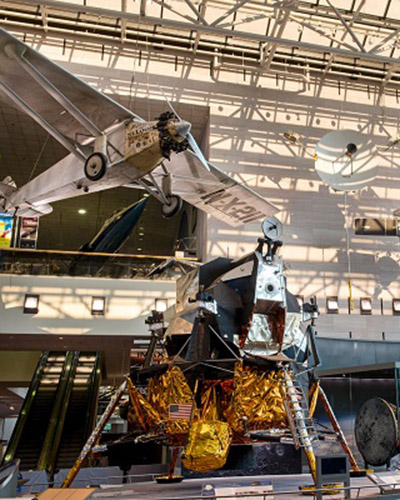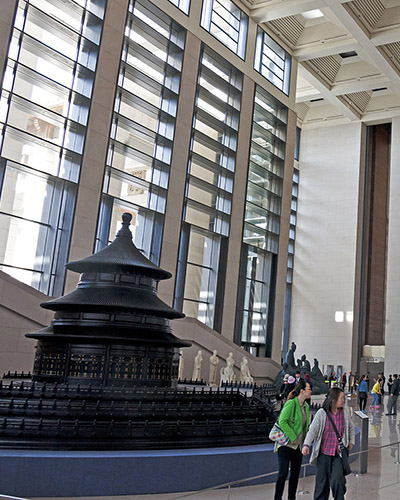Metropolitan Museum of Art
The Metropolitan Museum of Art of New York City, colloquially "the Met",[a] is the largest art museum in the
United States. Its permanent collection contains over two million works,[1] divided among 17 curatorial
departments. The main building at 1000 Fifth Avenue, along the Museum Mile on the eastern edge of Central
Park in Manhattan's Upper East Side, is by area one of the world's largest art galleries. A much smaller
second location, The Cloisters at Fort Tryon Park in Upper Manhattan, contains an extensive collection of
art, architecture, and artifacts from medieval Europe.
.jpg)
.jpg)
The museum's permanent collection consists of works of art from classical antiquity and ancient Egypt,
paintings, and sculptures from nearly all the European masters, and an extensive collection of American and
modern art. The Met maintains extensive holdings of African, Asian, Oceanian, Byzantine, and Islamic art.
The museum is home to encyclopedic collections of musical instruments, costumes, and accessories, as well as
antique weapons and armor from around the world. Several notable interiors, ranging from 1st-century Rome
through modern American design, are installed in its galleries.
The Metropolitan Museum of Art was founded in 1870 to bring art and art education to the American people.
The Fifth Avenue building opened on February 20, 1872, at 681 Fifth Avenue. In 2020, it was closed for 202
days due to the COVID-19 pandemic, and attracted only 1,124,759 visitors. This was a drop of 83 percent from
2019, but the Met still ranked ninth on the list of most-visited art museums in the world.
.jpg)
The Smithsonian gives an approximate number for artifacts and specimens of 146 million.[42] More
specifically, the collections include 30 million insects, 4.5 million plants preserved in the
Museum's herbarium, and 7 million fish stored in liquid-filled jars.[43] The National Collection of
Amphibians and Reptiles has more than tripled from 190,000 specimen records 1970 to over 580,000
specimen records in 2020.[44][45] Of the 2 million cultural artifacts, 400,000 are photographs
housed in the National Anthropological Archives.[43] Through off-site active loan and exchange
programs, the museum's collections can be accessed.[46] As a result, 3.5 million specimens are out
on loan every year.[43] The rest of the collections not on display are stored in the non-public
research areas of the museum and at the Museum Support Center, located in Suitland, MD.[47] Other
facilities include a marine science center in Ft. Pierce, Florida and field stations in Belize,
Alaska, and Kenya.
.jpg)
Collections
The Great Hall
The Smithsonian gives an approximate number for artifacts and specimens of 146 million.[42] More
specifically, the collections include 30 million insects, 4.5 million plants preserved in the
Museum's herbarium, and 7 million fish stored in liquid-filled jars.[43] The National Collection of
Amphibians and Reptiles has more than tripled from 190,000 specimen records 1970 to over 580,000
specimen records in 2020.[44][45] Of the 2 million cultural artifacts, 400,000 are photographs
housed in the National Anthropological Archives.[43] Through off-site active loan and exchange
programs, the museum's collections can be accessed.[46] As a result, 3.5 million specimens are out
on loan every year.[43] The rest of the collections not on display are stored in the non-public
research areas of the museum and at the Museum Support Center, located in Suitland, MD.[47] Other
facilities include a marine science center in Ft. Pierce, Florida and field stations in Belize,
Alaska, and Kenya.
The Musée du Louvre contains more than 380,000 objects and displays 35,000 works of art in eight curatorial
departments with more than 60,600 square metres (652,000 sq ft) dedicated to the permanent collection.[2]
The Louvre exhibits sculptures, objets d'art, paintings, drawings, and archaeological finds.[9] It is the
world's most visited museum, averaging 15,000 visitors per day, 65 percent of whom are foreign tourists.
.jpg)
Location and visit
The Hall of Dinosaurs has fossilized skeletons and cast models, including Tyrannosaurus rex cast facing
a Triceratops cast. The Triceratops exhibit shows the first accurate dinosaur skeleton in virtual
motion, achieved through the use of scanning and digital technology."[58][59] The collection consists of
46 "complete and important specimens" of dinosaurs.
Before the Grand Louvre overhaul of the late 1980s and 1990s, the Louvre had several street-level entrances,
most of which are now permanently closed. Since 1993, the museum's main entrance has been the underground
space under the Louvre Pyramid, or Hall Napoléon, which can be accessed from the Pyramid itself, from the
underground Carrousel du Louvre, or (for authorized visitors) from the passage Richelieu connecting to the
nearby rue de Rivoli. A secondary entrance at the Porte des Lions, near the western end of the Denon Wing,
was created in 1999 but is not permanently open.
.jpg)
The museum's entrance conditions have varied over time; artist visitors long had privileged access, a
feature that has disappeared over time. At the time of initial opening in 1793, the French Republican
calendar had imposed ten-days "weeks" (French: décades), the first six days of which were reserved for
visits by artists and foreigners and the last three for visits by the general public.[13]:37 In 1824, a new
regulation allowed public access only on Sundays and holidays; the other days the museum was open only to
artists and foreigners, except for closure on Mondays.[13]:39 That changed in 1855 when the museum became
open to the public all days except Mondays.[13]:40 It was free until 1922, when an entrance fee was
introduced except on Sundays.[13]:42 Since its post-World War II reopening in 1946,[13]:43 the Louvre has
been closed on Tuesdays, and habitually open to the public the rest of the week except for some holidays.
The use of cameras and video recorders is permitted inside, but flash photography is forbidden.
.jpg)
.jpg)
.jpg)
.jpg)
.jpg)
.jpg)







